- 1Institute of Space Propulsion, German Aerospace Center (DLR), Hardthausen, Germany
- 2Department of Physics, Technische Universität Darmstadt, Darmstadt, Germany
- 3Institute of Computer Science, University of Wuerzburg, Wuerzburg, Germany
Traditional spacecraft attitude control often relies heavily on the dimension and mass information of the spacecraft. In active debris removal scenarios, these characteristics cannot be known beforehand because the debris can take any shape or mass. Additionally, it is not possible to measure the mass of the combined system of satellite and debris object in orbit. Therefore, it is crucial to develop an adaptive satellite attitude control that can extract mass information about the satellite system from other measurements. The authors propose using deep reinforcement learning (DRL) algorithms, employing stacked observations to handle widely varying masses. The satellite is simulated in Basilisk software, and the control performance is assessed using Monte Carlo simulations. The results demonstrate the benefits of DRL with stacked observations compared to a classical proportional–integral–derivative (PID) controller for the spacecraft attitude control. The algorithm is able to adapt, especially in scenarios with changing physical properties.
1 Introduction
With increased access to space, the challenge of space debris is becoming an increasingly relevant topic. To keep space useable for future generations, space debris must be mitigated. The most effective mitigation measure includes active debris removal (ADR) of approximately five objects per year. This research investigates the challenge of the attitude control system (ACS) in ADR. The difficulty here is that often, the exact size, shape, and mass of the targeted debris objects are unknown. Furthermore, through the capturing process, the mass and inertia of the satellite system are changed, making it difficult for the ACS to maintain a stable position. In spacecraft attitude control, proportional–integral–derivative (PID) control remains a cornerstone due to its simplicity and computational efficiency (Show et al., 2002). For more complex, nonlinear attitude problems, more sophisticated algorithms, such as model predictive control or dynamic programming, can be used. Model predictive control implements a predictive model of the system to anticipate future behavior over a finite time horizon (Iannelli et al., 2022). The control inputs are optimized by minimizing a specific cost function. This generally performs better than PID algorithms but also requires more computational resources. In this research, a deep reinforcement learning (DRL) approach is investigated to solve this satellite attitude problem. DRL has the benefit of being very computationally efficient once the networks are trained. During the process of an ADR, the ACS system must handle the unknown and changing mass. To simulate this, the agent is trained with varying masses and must develop an appropriate control strategy using torques on the reaction wheels of the satellite. This application of DRL to the satellite attitude problem is not new and has shown great promise in the past. An overview can be found in Tipaldi et al. (2022). The partially known space environment, the time-varying dynamics, and the benefits of autonomy make it the perfect candidate for reinforcement learning (RL). Research on this topic has been mainly constricted to training the agent to develop a general algorithm independent of the inertia of the satellite. Allison et al. (2019) investigated the use of a proximal policy optimization (PPO) algorithm to find an optimal control strategy for the spacecraft attitude problem. The spacecraft was modeled as a rigid body, and the state space was defined by the error quaternion vectors. Even though the controller was trained with a single mass, the control policy obtained was able to achieve good performance for a range between 0.1 kg and 100,000 kg. Specifically, the DRL approach is suitable to develop a general solution that can handle a wide array of different masses. Although a general solution is suitable for many applications, some maneuvers require adaptability in attitude control. In an ADR scenario, the mass of the spacecraft system changes drastically, both after capture and after the release of the debris object. Due to the nature of the general approach, it is limited by the edge cases of very small or very high masses. An algorithm developed to perform optimally for masses between 500 kg and 1,000 kg might develop problems at very low masses, applying forces that are too large. In the ADR scenario, considerable research effort has been devoted to the rendezvous maneuver and the pre-docking proximity control. Xu et al. (2023) investigated a DRL approach to optimize rendezvous trajectories for fuel consumption. It is shown that the DRL approach is suitable for a large number of impulses. Jiang et al. (2023) solved an interception strategy with high uncertainty using a one-to-one DRL algorithm. The algorithm can develop a universal interception strategy, even in random environments. These works demonstrate the suitability of DRL for changing conditions and uncertain conditions. This work instead focuses on the scenario after the capture, where a detumbling must be performed. In this scenario, the mass of the spacecraft system changes drastically, both after capture and after the release of the debris object. This research aims to develop an approach that adapts its control strategy depending on the mass of the satellite. Because the mass of the spacecraft system cannot be measured directly, the algorithm must extract this from other measurements. The authors compare different strategies and investigate whether they improve the performance of the algorithm, especially for the previously described edge cases. In particular, stacked observations are employed. Stacked observations are the result of stacking several observations into one single state. The authors show that all control strategies effectively detumble the system. Controllers that cannot extract the dynamics of a system struggle to handle situations in which the masses are very low. In contrast, RL agents with stacked observations can master the situation even with small masses. A more detailed description of the theory behind the developed algorithms can be found in Section 2. The methodology needed to reproduce the results is presented in Section 3. In addition, the robustness of each approach is examined using a Monte Carlo analysis. The agents are presented with different scenarios. The analyzed strategies are then compared to a classical PID controller, a well-established feedback control strategy, in Section 4.
2 Theory
This chapter provides the necessary theoretical background for the spacecraft attitude control problem. Furthermore, an introduction to deep reinforcement learning and the applied algorithms is given, and the spacecraft attitude problem is described in detail.
2.1 Dynamic framework
2.1.1 Coordinate frames
Before specifying the spacecraft dynamics, a common reference frame needs to be defined. Two different coordinate frames are used in the simulation. The first one is the earth-centered inertial frame (ECI)
2.1.2 Spacecraft dynamics
The spacecraft is modeled as a rigid body. The satellite is equipped with three balanced reaction wheels, each aligned with one spin axis
The tilde operator designates the skew symmetric matrix, that is,
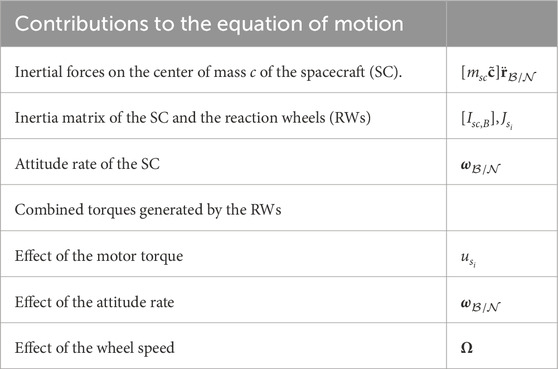
Table 1. Contributions to the EoM for the spacecraft equipped with reaction wheels. The EoM depends heavily on the mass and inertia of the spacecraft. The attitude rate and the wheel speed influence the effect the motor torque has on the spacecraft.
2.2 Deep reinforcement learning
The reinforcement learning problem can be characterized through the interaction of the agent with an environment. The agent is the learner and decision maker, while the environment provides the background and gives feedback to those decisions. The agent interacts with the environment in a discrete time step t through an action at. Afterward, the agent receives feedback in the form of the subsequent state st+1, which contains information about the environment. To evaluate the action, the agent also receives a numerical reward rt+1. The goal is to maximize the sum of discounted rewards in the long run. The sum of these rewards r is called the return R. Mathematically, the RL problem can be represented as a Markov decision process (MDP). If an environment satisfies the Markov property, it generally means the present state is only dependent on the immediate previous state. The MDP is defined by Eqs 4–9
with
The core RL objective is the maximization of the expected discounted return. A discount factor γ is used to weigh the future rewards and, therefore, determine how these are considered. The return Rt can then be written according to Eq. 10.
A policy π(at, st) is defined as the probability of selecting action at in state st. To evaluate the policy, the state-value function Eq. 11 is defined. Informally, this is the expected discounted return when starting in state st and following a policy π. From this, the action-value function Eq. 12 is defined. This is the expected return when starting in state st and taking action at and from there on following policy π
The state and the action-value function can be defined recursively. These recursive definitions are called the Bellmann and are displayed in Eqs 13 and 14:
The expected return J(π) associated with a policy is displayed in Eq. 15
The reinforcement learning problem can then be written in Eq. 16 as
where π* describes the optimal policy.
2.3 Soft actor-critic algorithm
The soft actor-critic (SAC) (Haarnoja et al., 2018) algorithm is an off-policy maximum entropy deep reinforcement learning algorithm. The goal is to maximize the expected reward and the entropy of the selected actions. SAC makes use of three major concepts.
2.3.1 Actor-critic algorithm
Actor-critic algorithms are usually based on policy iteration. Policy iteration describes the alternation between policy evaluation and policy improvement. In the policy evaluation step, the Q-value function (critic) is updated on the basis of the actor. In the policy improvement step, the parameters Φ of the policy πΦ are updated with the critic.
2.3.2 Off-policy algorithm
The off-policy paradigm helps increase sample efficiency through the reuse of previously collected data. Off-policy algorithms have the advantage of distinguishing between the current policy and the behavioral policy. The current policy can be updated with collected transitions (st, at, rt, st+1) that are sampled by another policy. Therefore, it is possible to use data that were collected by an old policy to update the current policy. The SAC algorithm makes use of an experience replay buffer, which is a set
2.3.3 Entropy maximization
Entropy is a metric that describes the randomness of a random variable (Open AI, 2018b). The entropy
Entropy-regularized reinforcement learning extends the objective function by an entropy objective
where α describes the temperature parameter. This determines the relative importance of the entropy term against the reward term. Therefore, it controls the stochasticity of the optimal policy. The extension by the entropy objective has the advantage of incentivizing the policy to explore the state-action space and make the policy more robust.In practice, SAC uses neural networks as function approximators for the parameterized soft Q-function Qθ(st, at) and the tractable policy πΦ(at, st), where θ and Φ describe the parameters of the neural networks. The soft Q-function is trained by minimizing the soft Bellmann residual error, displayed in Eq. 19.
The value function Eq. 20 is implicitly parameterized through the soft Q-function
The target network function, denoted by
2.4 Proximal policy optimization
Proximal policy optimization (PPO) (Schulman et al., 2017; Open AI, 2018a) is an often-used reinforcement learning algorithm. The core idea of PPO is to take policy updates that are as far apart as possible without causing the performance to diverge. PPO is an actor-critic on-policy algorithm.
2.4.1 On-policy algorithm
An on-policy algorithm iterates through two phases. At first, the agent samples data. In the second step, the agent updates its policy with the sampled data. Because the samples need to be generated with the policy that should be updated, all the training data are obsolete after an update has been performed. The agent must sample data again after every update.PPO updates its policy with an advantage function A(st, at); such as the ones given in Eqs 22 and 23.
The advantage function A(st, at) provides a measure of how good action at is compared to the expected value of being in state st. Because A(st, at) can be defined by the value function V(st), PPO uses an actor network and a value function network. The value network is trained using the Bellmann equation. The policy is updated via Eq. 24.
Here, L is given in Eqs 25 and 26.
where
The hyperparameter ϵ controls the deviation between the old and the new policy and is, therefore, responsible for ensuring the update steps are not too large.
2.5 Stacked observations
Reinforcement learning is often influenced by hidden variables. Hidden variables are properties of the environment that are not present in the state of the RL problem but that have an influence on the dynamics of the system, such as the mass of an object. Although the hidden variables are not part of the state, the agent must be able to derive them in order to control the system optimally. In this work, we use stack past observations and actions to make the system dynamics accessible to the agent. Using this metric, the agent can analyze the historical states to infer details about how the system’s behavior changes over time.
3 Methodology
This section describes the simulation setup and the application of the RL algorithms to the spacecraft attitude problem.
3.1 Simulation architecture
The attitude problem is simulated within the astrodynamic framework Basilisk (2024). This framework provides Python modules written in C/C++. It is being developed by the University of Colorado Autonomous Vehicle Systems (AVS, 2023) and the Laboratory for Atmospheric and Space Physics (LASP, 2023). The simulation environment has no aerodynamic, gravitational, or solar radiation pressure effects. The simulations are visualized by the accompanying software, Vizard (2023). The simulation software is connected to the RL framework RLlib (2023) through OpenAI Gym.
The simulation architecture is shown in Figure 1. The spacecraft module describes the spacecraft as a rigid body. The gravityEffector module provides the necessary orbital dynamics for a low earth orbit. The simpleNav module provides the current attitude, attitude rate, and position of the spacecraft. The inertial3D module provides the attitude goal. In the attTrackingError module, this goal is used to compute the difference between the desired attitude and the current attitude. The result is then given as feedback to the agent. The agent provides a torque input to the rwMotorTorque module, which maps these onto the three reaction wheels. The reaction wheel speed Ω is then given as feedback to the agent. The different scenarios described in the following sections were implemented through the initialConditions module. The agent and the simulation communicate through an OpenAI Gym interface. The agent is trained using the SAC (2023) and PPO (2023) algorithms included in RLlib.
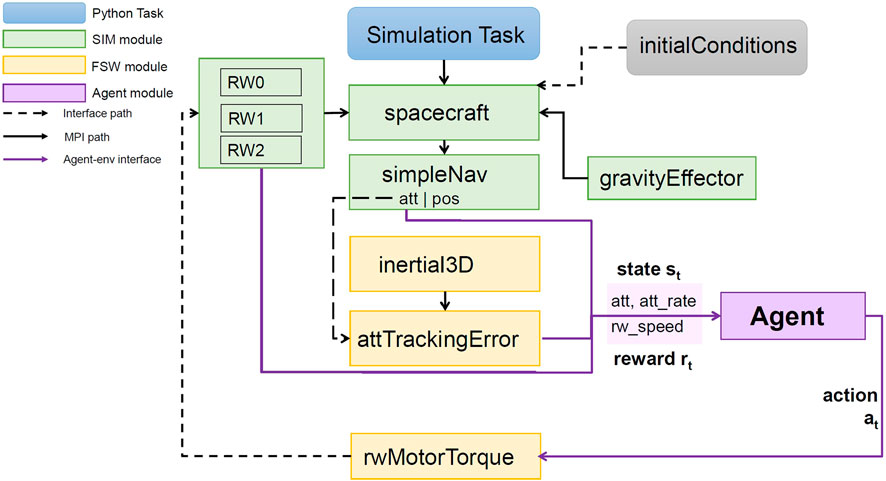
Figure 1. Simulation architecture and agent interface. The simulation (SIM) and flight software (FSW) modules communicate through the message-passing interface (MPI). The agent receives the state st from the environment. The state contains the attitude
3.2 State and action space
A satellite equipped with reaction wheels used for attitude control is simulated. Three reaction wheels are set up to control the three axes of the satellite. The attitude tracking error
The reaction wheels are modeled after a standard set of reaction wheels like the Honeywell (2023) HR16. In compliance with this, the action space boundaries are set to umin = −0.2 Nm and umax = 0.2 Nm. The state s is defined with the reaction wheel speed Ω in the following Eq. 28.
3.3 Training
In the training scenario, a fixed initial attitude
3.4 Reward modeling and RL parameters
The main objective of the agent is to reach the desired orientation. For this purpose, an attitude error is defined on which the reward is based. The attitude error
Using this definition, the reward is defined in Eq. 31.
The first term of the reward function is to avoid saturation of the reaction wheels at their maximum wheel speed Ωmax. The main objective is to minimize the norm of the attitude error
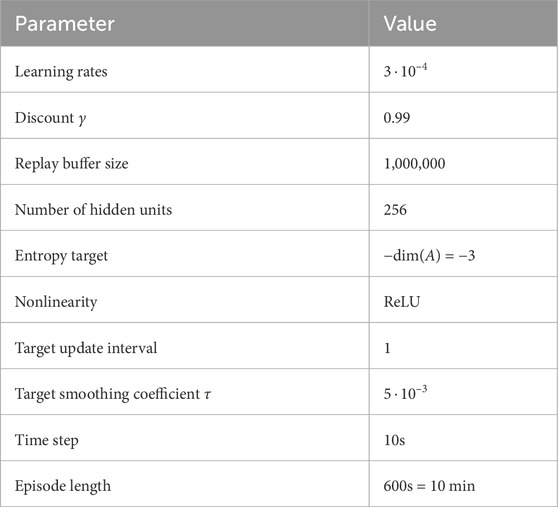
Table 2. Training parameters for the SAC algorithm, including the RL hyperparameters and the environment parameters. The learning rates refer to three different learning rates: The actor network, the Q-value network, and the α parameter. The rectified linear unit (ReLU) is chosen as the activation function. This function returns the input if the input is positive and zero otherwise.
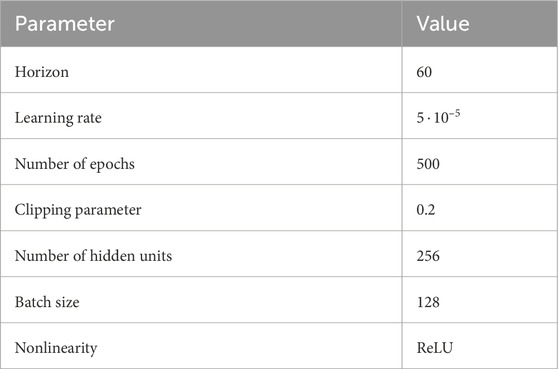
Table 3. Training parameters for the PPO algorithm. For the RL hyperparameters and the environment parameters, see Table 2.
3.5 PID controller
To evaluate the performance of the DRL algorithms, a simple PID controller is implemented and interfaced with Basilisk. The PID controller is tuned with a spacecraft mass of m = 300 kg. This represents roughly the median of the considered mass range while being slightly optimized for lower masses. This optimization is considered because high forces have a stronger effect on low masses. To tune the PID controller, the parameters are first approximated by hand, after which a Nelder and Mead (1965) optimization is employed to find the values for which the return is maximized. The parameters then correspond to: kp, ki, kd = (0.36, 0.00015, 14.02). As input to the PID controller, the attitude error
4 Results
In this section, the respective algorithms are evaluated and compared in terms of their achieved return and the final attitude error. First, the evaluation method is presented, and second, the results are discussed. The evaluation shows that the DRL algorithms with stacked observations outperform both the DRL without stacked observations and the classical PID controller.To evaluate the different algorithms, the trained agent is tested in the environment for 1,000 episodes. The initial and desired attitudes are the same as those used in the training. For each episode, the mass is uniformly sampled between 10 kg and 1,000 kg. The 1,000 episodes are then evaluated on the basis of the following metrics: Return R: The mean return reached in each episode, including the standard deviation.
The results of the training metrics are listed in Table 4.
The PPO algorithm with stacked observations achieves the best performance overall. Although the confidence interval of the attitude error
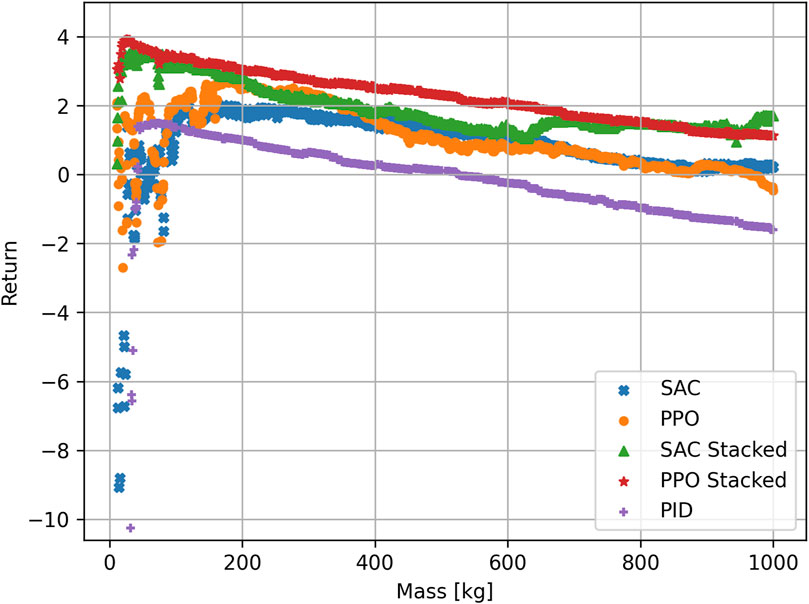
Figure 2. Return for the different algorithms plotted over the mass of the satellite. The PPO stacked algorithm achieves the best return overall. The algorithms with no stacked observations have difficulty in the low mass range. For visibility purposes, only returns to a minimum of −11 are shown.
For most mass cases, the PID algorithm achieves a return within the same range. This explains the small CI of the final attitude error. The PID algorithm provides a very predictable return for masses m ≥ 100 kg, while for the DRL algorithms, the returns are higher in general but show a larger spread. The algorithms without stacked observations are not able to handle masses between 10 kg and 100 kg. Because the algorithms have no way to extract the mass from the observations, the agents try to generalize and optimize the actions for all masses. The algorithms maximize the expected return over all possible masses, which is why the return is slightly optimized for lower masses. By doing this, the agent must find a balance between applying a force that is too small to move the higher masses and applying a force that is too strong for the low masses. In the end, the actions are slightly more optimized toward lower masses because the negative effect of wrong actions is stronger here. This is evident in the shape of the return/mass curve, which starts negative and then reaches a maximum at approximately 200 kg, after which the return slightly decreases. The decrease in the return is due to the fact that the satellite needs a longer time to reach the desired orientation, with the force optimized for masses approximately 200 kg.
The SAC and PPO algorithms achieve slightly different curves. Although the mean return is in a similar range, the PPO algorithm performs slightly better at low masses. The optimization problem has different solutions: The SAC algorithm achieved a more generalized approach that achieves a consistent return for higher masses. The PPO algorithm achieves better results at low masses but performs worse at higher masses. The classical PID algorithm shows a very stable behavior for a wide array of masses but also fails to stabilize the satellite in the low mass range. This shows that a PID controller is not suitable for handling both low and very high masses because the tuning parameters would be vastly different.
When using stacked observation, the agent is able to extract the dynamics of the spacecraft. By stacking the observations together, the agent can make a connection between the force applied and the reaction of the spacecraft over the course of five observations. This helps to stabilize the satellite, even at low masses. Instead of developing a generalized algorithm and applying the same actions to each mass, the agent learns to apply different actions depending on the mass. To further demonstrate the different behavior of the SAC agents with and without stacked observations, both agents are tested in one episode for a mass of m = 15 kg. The resulting evolution of the attitude error and the applied torques can be found in Figure 3. The agent without stacked observations reaches a return of R = −8.91, and the oscillating behavior around the desired orientation is clearly visible in Figure 3A. The agent applies torques that are optimized for masses approximately 200 kg. This results in the satellite overshooting the desired target. To mitigate this, the agent then applies a torque in the opposite direction. Again, this torque is too strong, causing another overshoot. The algorithm is unable to adapt to the fact that the mass is now significantly lower than those for which the algorithm optimized. The applied torque does not change in amplitude. On the other hand, the agent that uses stacked observations instead reaches a return of R = 2.95 and manages to stabilize the satellite with a stabilizing time of t = 260 s. After initially applying a large torque, the agent implements the feedback gained by the stacked observations to lower the force of the torque (Figure 3D). This allows the agent to stabilize the satellite at the desired orientation. The final attitude errors for SAC are [60.31, −27.02, −47.54]° and
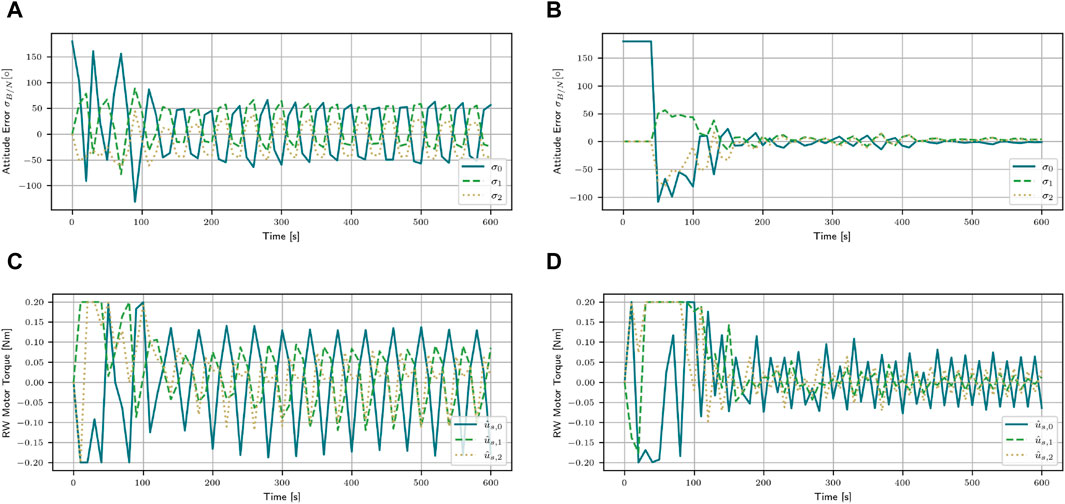
Figure 3. Attitude error and the applied motor torques for the mass of m = 15 kg with the SAC agent with and without stacked observations. Using stacked observations enables the agent to stabilize the satellite, even at low masses. (A) Attitude error for the SAC algorithm. (B) Attitude error for the SAC stacked algorithm. (C) Applied torques for the SAC algorithm. (D) Applied torques for the SAC stacked algorithm.
For further comparison, the PID controller is compared to the SAC stacked algorithm for m = 300 kg. This mass corresponds to the mass the PID controller was tuned with. This comparison will aid in explaining the difference between the two algorithms.
Both algorithms bring the attitude error close to zero. The SAC stacked algorithm reaches a return of R = 2.16, while the PID controller reaches R = 0.65. The final attitude error of the SAC stacked algorithm is [0.37, −1.94, −2.57]° and
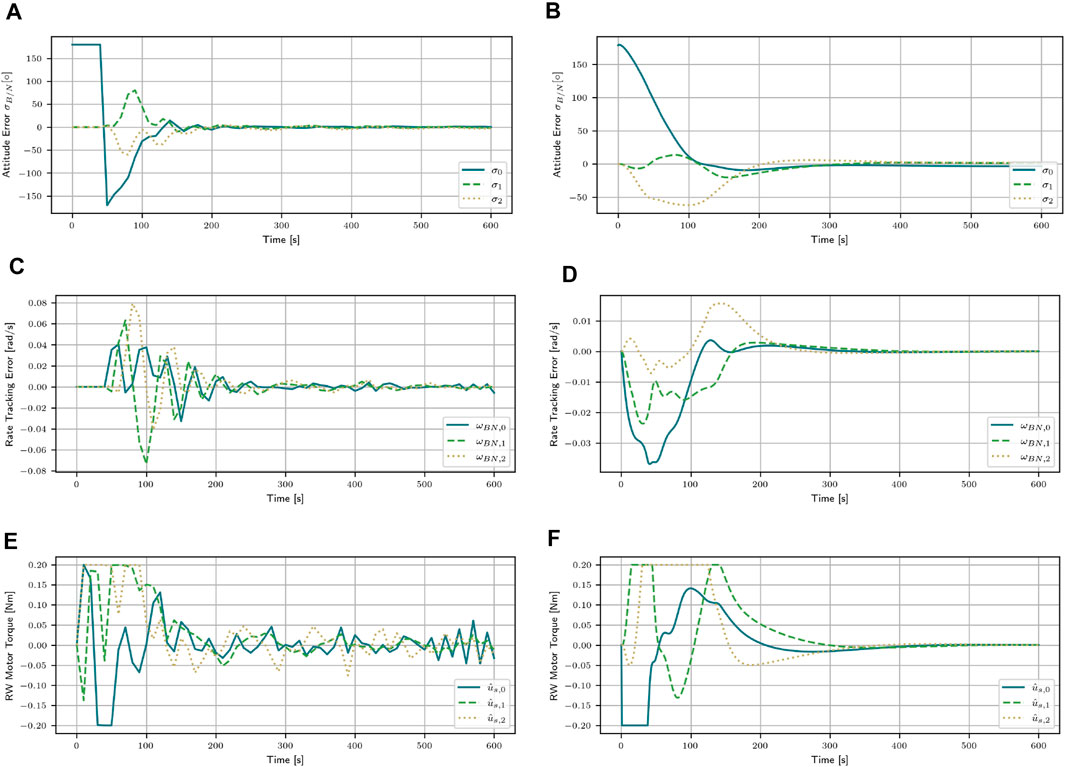
Figure 4. Attitude error, attitude rate error, and the applied motor torques for the mass of m = 300 kg with the SAC agent with stacked observations and the PID controller. (A) Attitude error for the SAC stacked algorithm. (B) Attitude error for the PID controller. (C) Attitude rate error for the SAC stacked algorithm. (D) Attitude rate error for the PID controller. (E) Applied torques for the SAC stacked algorithm. (F) Applied torques for the PID controller.
5 Conclusion and further study
This study demonstrated the great promise of DRL techniques, especially in combination with stacked observations. For scenarios where a high variation in mass is possible, such as active debris removal, the satellite ACS system must be highly adaptable for a wide range of possible masses. DRL algorithms without stacked observations are already able to handle the attitude control well, but they achieve similar results as a PID controller. Employing stacked observations significantly increases the performance of the DRL controller, especially for a low mass range. This technique enables the agent to extract mass information without measuring the mass directly. This is very valuable when dealing with the unknown space debris environment. Both the SAC and PPO algorithms achieved similar results.
These results establish a basis for further study. In the future, a higher varying mass range in combination with varying initial attitudes will be investigated. Combining these would lead to developing a robust attitude controller that can adapt its control based on the dynamics of the spacecraft. In this study, the mass variation was set before each episode. In a rendezvous maneuver, the mass would change from one time step to the next. The algorithm would have to adapt immediately. This change in mass during the episode will be investigated in future works.
Data availability statement
The raw data supporting the conclusion of this article will be made available by the authors, upon request.
Author contributions
WR: writing–original draft and writing–review and editing. JD: writing–original draft and writing–review and editing. GW-W: funding acquisition, project administration, supervision, and writing–review and editing.
Funding
The author(s) declare that no financial support was received for the research, authorship, and/or publication of this article.
Conflict of interest
The authors declare that the research was conducted in the absence of any commercial or financial relationships that could be construed as a potential conflict of interest.
Publisher’s note
All claims expressed in this article are solely those of the authors and do not necessarily represent those of their affiliated organizations, or those of the publisher, the editors, and the reviewers. Any product that may be evaluated in this article, or claim that may be made by its manufacturer, is not guaranteed or endorsed by the publisher.
References
Alcorn, J., Allard, C., and Schaub, H. (2018). Fully coupled reaction wheel static and dynamic imbalance for spacecraft jitter modeling. J. Guid. Control, Dyn. 41, 1380–1388. doi:10.2514/1.G003277
Allison, J., West, M., Ghosh, A., and Vedant, F. (2019) Reinforcement learning for spacecraft attitude control (70th International Astronautical Congress).
AVS (2023). Autonomous vehicle systems. Available at: https://hanspeterschaub.info/AVSlab.html (Accessed October 10, 2023).
Basilisk (2024). Basilisk. Available at: https://hanspeterschaub.info/basilisk/(Accessed February 21, 2024).
Haarnoja, T., Zhou, A., Abbeel, P., and Levine, S. (2018) Soft actor-critic: off-policy maximum entropy deep reinforcement learning with a stochastic actor. CoRR abs/1801.01290.
Honeywell (2023). Hr16 datasheet. Available at: https://satcatalog.s3.amazonaws.com/components/223/SatCatalog_-_Honeywell_-_HR16-100_-_Datasheet.pdf (Accessed October 7, 2023).
Iannelli, P., Angeletti, F., and Gasbarri, P. (2022). A model predictive control for attitude stabilization and spin control of a spacecraft with a flexible rotating payload. Acta Astronaut. 199, 401–411. doi:10.1016/j.actaastro.2022.07.024
Jiang, R., Ye, D., Xiao, Y., Sun, Z., and Zhang, Z. (2023). Orbital interception pursuit strategy for random evasion using deep reinforcement learning. Space Sci. Technol. 3, 0086. doi:10.34133/space.0086
LASP (2023). Laboratory for atmospheric and space physics. Available at: https://lasp.colorado.edu/.
Nelder, J. A., and Mead, R. (1965). A simplex method for function minimization. Comput. J. 7, 308–313. doi:10.1093/comjnl/7.4.308
Open AI (2018a). Proximal policy optimization. Available at: https://spinningup.openai.com/en/latest/algorithms/ppo.html (Accessed March 06, 2024).
Open AI (2018b). Soft actor-critic. Available at: https://spinningup.openai.com/en/latest/algorithms/sac.html (Accessed March 15, 2024).
PPO (2023). Algorithm. Available at: https://docs.ray.io/en/latest/rllib/rllib-algorithms.html#ppo (Accessed October 10, 2023).
RLlib (2023). Algorithm. Available at: https://docs.ray.io/en/latest/_modules/ray/rllib/(Accessed October 10, 2023).
SAC (2023). Algorithm. Available at: https://docs.ray.io/en/latest/_modules/ray/rllib/algorithms/sac/sac.html (Accessed October 10, 2023).
Schaub, H. (2023). Reaction wheel scenario. Available at: https://hanspeterschaub.info/basilisk/examples/scenarioAttitudeFeedbackRW.html (Accessed October 10, 2023).
Schaub, H., and Junkins, J. L. (2018) Analytical mechanics of space systems. 4th edn. Reston, VA: AIAA Education Series. doi:10.2514/4.105210
Schulman, J., Wolski, F., Dhariwal, P., Radford, A., and Klimov, O. (2017) Proximal policy optimization. CoRR abs/1707.06347.
Show, L.-L., Juang, J., Lin, C.-T., and Jan, Y.-W. (2002). “Spacecraft robust attitude tracking design: pid control approach,” in Proceedings of the 2002 American control conference (IEEE cat. No.CH37301) 2, 2, 1360–1365. doi:10.1109/acc.2002.1023210
Tipaldi, M., Iervolino, R., and Massenio, P. R. (2022). Reinforcement learning in spacecraft control applications: advances, prospects, and challenges. Annu. Rev. Control 54, 1–23. doi:10.1016/j.arcontrol.2022.07.004
Vallado, D. A., and McClain, W. D. (2001) Fundamentals of astrodynamics and applications. Portland, Oregon: Microcosm Press.
Vizard (2023). Vizard. Available at: https://hanspeterschaub.info/basilisk/Vizard/Vizard.html (Accessed October 10, 2023).
Keywords: attitude control, deep reinforcement learning, adaptive control, spacecraft dynamics, varying masses, space debris, active debris removal
Citation: Retagne W, Dauer J and Waxenegger-Wilfing G (2024) Adaptive satellite attitude control for varying masses using deep reinforcement learning. Front. Robot. AI 11:1402846. doi: 10.3389/frobt.2024.1402846
Received: 18 March 2024; Accepted: 30 May 2024;
Published: 23 July 2024.
Edited by:
Antonio Genova, Sapienza University of Rome, ItalyReviewed by:
Daniel Condurache, Gheorghe Asachi Technical University of Iași, RomaniaHaibo Zhang, China Academy of Space Technology, China
Copyright © 2024 Retagne, Dauer and Waxenegger-Wilfing. This is an open-access article distributed under the terms of the Creative Commons Attribution License (CC BY). The use, distribution or reproduction in other forums is permitted, provided the original author(s) and the copyright owner(s) are credited and that the original publication in this journal is cited, in accordance with accepted academic practice. No use, distribution or reproduction is permitted which does not comply with these terms.
*Correspondence: Wiebke Retagne, d2llYmtlLnJldGFnbmVAd2ViLmRl; Günther Waxenegger-Wilfing, Z3VlbnRoZXIud2F4ZW5lZ2dlckBkbHIuZGU=
 Wiebke Retagne
Wiebke Retagne Jonas Dauer
Jonas Dauer Günther Waxenegger-Wilfing1,3*
Günther Waxenegger-Wilfing1,3*